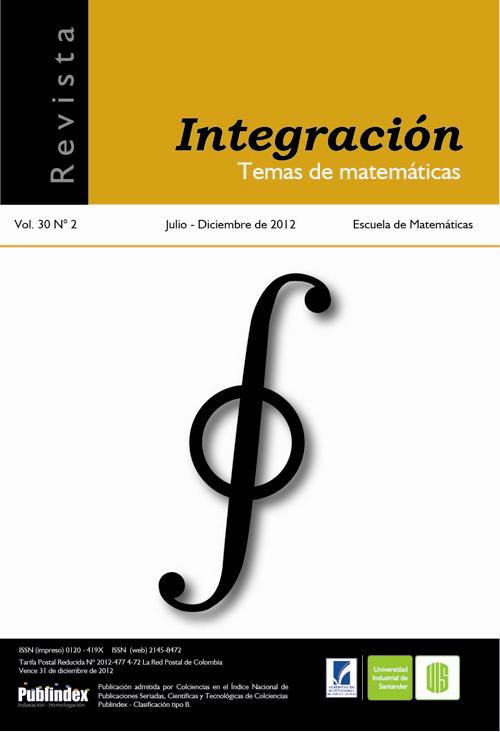Publicado 2012-11-28
Palabras clave
- Combinatoria sobre cadenas,
- cadena infinita de Fibonacci,
- homomorfismos entre lenguajes,
- curvas fractales,
- L-sistemas
- Mathematicar ...Más
Cómo citar
Resumen
En este artículo se hace una implementación con el software Mathematica 8.0 de algunas propiedades combinatorias de la cadena o palabra de Fibonacci, la cual se puede generar a partir de la iteración de un homomorfismo entre lenguajes. Asimismo se recopilan algunas propiedades gráficas de la curva fractal asociada a esta cadena de símbolos, la cual se puede generar a partir de unas reglas de dibujo análogas a las utilizadas en los L-Sistemas. Todos los códigos utilizados en el artículo se presentan en detalle y luego se aplican para generar nuevas curvas fractales. Finalizamos con una forma alternativa de generar la curva de Fibonacci y otras curvas a partir de cadenas características.
Descargas
Referencias
[2] Allouche J.-P., Shallit J.,“The ubiquitous Prouchet-Thue-Morse sequence”, En Ding C., Helleseth T., Niederreiter H., editors, Sequences and their Applicactions, Proceedings of SETA’98, Springer Verlag (1999), 1–16.
[3] Allouche J.-P. Shallit J., Automatic Sequences, Cambridge University Press, Cambridge, 2003.
[4] Allouche J.-P. Skordev G., “Von Koch and Thue-Morse revisited”, Fractals 15 (2007), no. 4, 405–409.
[5] Dekking F.M. “Recurrent sets”, Adv. in Math. 44, (1982), no. 1, 78–104.
[6] Dekking F.M., “Replicating superfigures and endomorphisms of free groups”, J. Combin. Theory Ser. A 32 (1982), 315–320.
[7] Dekking F.M., Mendès M., “Uniform distribution modulo one: a geometrical viewpoint”, J. Reine Angew. Math. 329 (1981), 143–153.
[8] Deshouillers J.-M., “Geometric aspects of Weyl sums”, Elementary and analytic theory of numbers (Warsaw, 1982), Banach Center Publ. 17 (1985), 75–82.
[9] Griswold R.E., “The Morse-Thue Sequence”, Dep. of Computer Science, The University ofn Arizona. http://www.cs.arizona.edu/patterns/weaving/
[10] Von Koch H., “Une méthode géométrique élémentaire pour l’étude de certaines questions de la théorie des courbes planes”, Acta Math. 30 (1906), no. 1, 145–174.
[11] Lothaire M., Combinatorics on Words, Cambridge University Press, Cambridge, 1983.
[12] Lothaire M., “Algebraic Combinatorics on Words”, Encyclopedia of Mathematics and its Applications, Cambridge University Press, Cambridge, 2002.
[13] Lothaire M., “Applied Combinatorics on Words”, Encyclopedia of Mathematics and its Applications, Cambridge University Press, Cambridge, 2005.
[14] Ma J., Holdener J. “When thue Morse meets Koch”, Fractals 13 (2005), no. 3, 191–206.
[15] Monnerot A., “The Fibonacci Word Fractal”, preprint (2009). http://hal.archives-ouvertes.fr/hal-00367972/fr/
[16] Morse M., “Recurrent geodesics on a surface of negative curvature”, Transactions Amer. Math. Soc. 22 (1921), no. 1, 84–100.
[17] Morse M., Hedlund G., “Symbolic Dynamics II: Sturmian Sequences”, Amer. J. Math. 62 (1940), 1–42.
[18] Prusinkiewicz P., Lindenmayer A., The algorithmic beauty of plants, Springer-Verlag. New York, 2004.
http://algorithmicbotany.org/papers/abop/abop.pdf.
[19] Prusinkiewicz P., “Graphical applications of L-systems”, Proceedings of Graphics Interface (ed. Wein M. and Kidd E.M.), Canadian Information Processing Society (1986), 247–253.
[20] Schützenberger M-P., “Une théorie algébrique du codage,” In Séminaire Dubreil-Pisot 1955–56, Exposé No. 15, (1955).
[21] Siromoney R., Subramanian K., “Space-filling curves and infinite graphs”, Graph grammars and their application to computer science (ed. Ehrig H., Nagl M. and Rozenberg G.), Second International Workshop, Lecture Notes in Computer Science 153, Springer-Verlag, Berlin (1983), 380–391.
